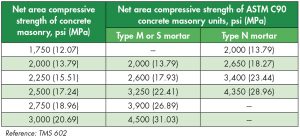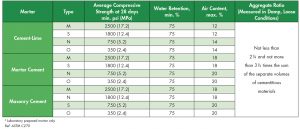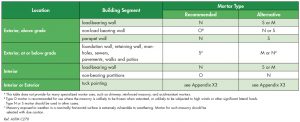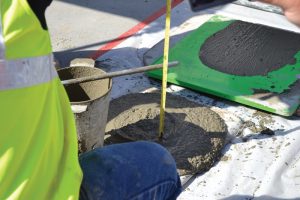How Much is Enough?
Structural engineers often get a greater level of comfort by specifying masonry component strengths higher than are needed. However, this can be counterproductive since some masonry components, such as mortar, may sacrifice bond in lieu of strength, leading to cracking and water intrusion into structural masonry walls. Masonry grout may also be considered a form of concrete, which it is not. A better approach is understanding how the individual materials work together based on code requirements supported by extensive research. The ultimate goal should be to specify masonry components that are economical with maximum structural integrity.
The Masonry System
Concrete block masonry is designed as a homogeneous system that assumes the compression components of masonry units, mortar, and grout are equal. Code design parameters are conservative, which takes into account that there will be some variation in material properties. Joint reinforcement or structural deformed reinforcement, if present, are sole tension components and not subject to multiple material variations.

Based on the Unit Strength Table 2 of The Masonry Society’s TMS 602, Specification for Masonry Structures, and minimum strength requirement of 2,000 psi for concrete masonry units as required by ASTM C90, Standard Specification for Loadbearing Concrete Masonry Units, the natural design threshold for concrete block masonry is 2,000 psi. When one looks at TMS 602, Table 2, the 2,000 psi strength verification is based on Type M or S mortar, but the strength verification is reduced to 1,750 psi when using Type N mortar. The natural instinct is that more strength yields better performance, but this is not always true. Mortar with less cement content provides a better bond to the masonry unit, mitigating or eliminating moisture intrusion into the masonry system. Moisture intrusion can lead to walls that leak which is never desirable.
Table 2 in TMS 602 lists Unit Strength verifications in increments of 250 psi which provides thresholds for design compressive strengths above 2,000 psi; however, the availability of unit strength from local concrete block producers must be confirmed.
Masonry Units
Masonry unit strength is the primary component when considering compressive strength design of masonry. Mortar and masonry grout naturally vary in strength properties, and the goal should be to specify strengths compatible with the masonry units.
Even though ASTM C90 requires the minimum compressive strength of concrete masonry units to be 2,000 psi, units are typically manufactured at strengths 20 to 30% greater than the minimum. This provides unit strengths that are comfortably compliant without far greater than desirable strength.
Mortar
Mortar is unquestionably the most misunderstood component of masonry. The consensus seems to be that mortar strength less than the masonry design strength means that the actual system strength is inadequate, but that is not true. When tested as an individual component, there are two primary reasons that mortar does not replicate the actual mortar strength in the masonry wall.
- The aspect ratio (height divided by width) of mortar in a masonry wall is not reflected in the test specimen (3⁄8 inch to 1¼ inches for mortar joint in a wall vs. 1:1 or 2:1 in a test specimen).
- The moisture curing content in a test specimen is not similar to that in a masonry wall (masonry units absorb excess moisture whereas specimen form does not).

There are 13 statements within 3 ASTM Standards (ASTM C270, C780, C1586) addressing masonry mortar field testing and explaining why mortar strengths do not directly correlate to the compressive strength values contained in ASTM C270 Table 1. Additionally, the table notes that the application is for laboratory-prepared mortar only.
Other published information on masonry mortar explains the strength disparity between mortar in a masonry wall and mortar test specimens. The National Concrete Masonry Association and the Brick Industry Association publish information on mortar testing and performance and consistently explain why field-tested mortar compressive strength is not representative of mortar strength in the wall and how bond strength is essential to take into consideration.
The Code (TMS 602) and Material Standards should be used as guidance to specify the mortar most compatible with the masonry unit and wall system. The Code contains certain seismic limitations, and the Material Standard, ASTM C270, provides valuable recommendations. However, neither source goes in the direction of recommending compressive strength, and this absence of recommendations acknowledges that mortar prepared by proportion without testing for compressive strength safely provides a performing masonry wall system. Type M or S mortar is required by TMS 402, Building Code Requirements for Masonry Structures, for participating elements (shear walls) in Seismic Design Category D and above.
One often overlooked but very useful resource is contained in the Appendix of ASTM C270. Table X1.1 is a guide for the Selection of Masonry Mortars.
There are 4 mortar classifications by Type, M, S, N, and O. Type M has the highest Portland cement content and Type O the lowest. Mortar bond is enhanced by lower Portland cement content which results in the industry recommendation that the most appropriate mortar selection is the one providing the best bond while complying with Code requirements.
Type M mortar should be used sparingly. Applications would include the need for durability, such as retaining walls, or when very high design strengths are specified. For structural walls in high Seismic Design Categories (D and above), Type S mortar is most appropriate, and Type N mortar is typical for structural walls in lower Seismic Design Categories.

Grout
Masonry grout has many similarities with concrete, so it is natural to think of grout as a different type of concrete. Unfortunately, this can lead to specifying or providing grout that may not be appropriate for masonry walls.
The first thing to consider is that grout, unlike concrete, must be a very high slump mixture to flow in the restricted and congested spaces in the cells of masonry units. The Code (TMS 602) and Material Standard (ASTM C476) require a slump of 8 to 11 inches, unthinkable in a concrete world. The next process in the placement of masonry grout is that the excess water is immediately absorbed by the masonry units, placing the grout in a moisture state similar to concrete.

Also important is the aggregate size. With the small cell spaces accommodating grout, the limitation of coarse aggregate is generally 100% of the aggregate passing the ½-inch sieve, with a maximum of 15% of the aggregate retained on a 3⁄8-inch sieve (reference ASTM C404, Standard Specification for Aggregates for Masonry Grout).
These differences are rarely an issue for pre-blended grout or grout mixed in the field, but when larger volumes of grout are supplied by ready-mixed trucks, the grout is proportioned by a design mix. Unfortunately, the design mix is often generated by software sensitive to the properties of concrete. This can lead to grout design mixes that are enhanced with plasticizers that replace water and may ultimately lead to an insufficient amount of water to hydrate the masonry grout adequately. Alternately, the design may increase the content of Portland cement to compensate for the perceived high water content in grout during the curing process. This can easily lead to grout strengths of 3,000 to 4,000 psi or more which is wasteful and environmentally unfriendly by using more Portland cement than needed.
The masonry grout should be specified to the minimum of 2,000 psi or the design strength, whichever is greater. Then submittals should be closely reviewed so that the proposed grout is not a modified form of concrete but truly a grout submittal. Using grout that is reasonably close to the masonry unit strength provides a structural masonry system that follows the intent of the Code.
Summary
Structural masonry walls are designed as a homogeneous system, and specifying and providing components with reasonably close properties is economical and structurally sound. The designer should consider that neither masonry units nor masonry grout should be excessively above the design strength. Additionally, mortar is not the weak link in the compressive strength chain and should not be specified by compressive strength. Mortar bond strength, obtained by using a softer mortar with less Portland cement, is a key property that is rarely given the appropriate recognition.■
